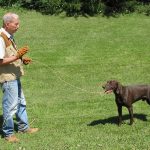Pointing Dog Pointers: Come Here!
by Bob and Jody Iler
One of the most important commands your pointing dog learns is Come. This is the command that can save his life, teach him to reliably retrieve a bird to hand, and help him to form that crucial bond with you as his hunting partner and lifetime companion.
Also known as the recall exercise in obedience, some people use different words, such as Front in directing their dogs to come to them. We like to use the word “Here!” Spoken with authority, the command Here comes from the diaphragm, and can be heard from a good distance away even on a windy day. Whatever word you choose, be consistent and brief. Don’t make it into a sentence such as “C’mon, get over here, good boy!” And don’t scold and use an angry voice such as “You come here right now, you bad dog!”
Most important of all, be prepared to enforce the command at exactly the same moment you give it. You’re not asking your dog to come if he feels like it. You’re making it clear that he is to come directly and immediately to you when you call him. We’ve all heard folks calling their dogs repeatedly, getting louder and more frustrated each time they repeat the command . After you show pup what you want, there’s just no sense in giving him a command if you have no way to enforce it.
Enter the Checkcord!
Or, in the case of pups, a light 20-foot clothesline that doesn’t crinkle works well and won’t intimidate the young pupil. Tie a snap to one end for easy daily use. For these youngsters, no training collar is needed, just a flat collar will do, with the light line attached. Most little puppies love to come to us and follow us about, so this is the time to reinforce what they are already doing and let them know what smart fellows they are.
Give lots of praise to pup as you command Here and he comes running to you! Squat down and clap your hands as you praise and encourage him. At this stage, treats are a great help for little chowhound pups. If they’re not foodies, lots of praise will keep those tails wagging and have them responding well to your command to come. Ease off the treats as pup grows. You want him to respond because he’s pleasing you. As pup grows and develops confidence, you can replace the clothesline with a 20-foot checkcord attached to the flat collar. During this “baby” phase, we keep things fun and positive, and let our pup get out there and explore everything. We don’t worry about the heel, whoa, or other control commands right now.
Sadly, just like adolescent kids, the day comes when there are other, more exciting things to attract your pup’s attention, causing him not to respond to your command to come! Now, let your young pup range out and explore as he pays no attention to you. Next, make sure your line is fairly taut before you firmly and loudly give the Here command, straight from your diaphragm. At the very same moment, pop that checkcord so he feels it and you get his attention. If he doesn’t turn and run toward you, repeat the command and the pop on his neck simultaneously, backing up as you do to encourage him to come to you. After a few sessions of this your pup will get the idea that you mean business, and when you say “Here,” will turn quickly and come running to you.
Don’t overdo these lessons. A short session daily works wonders. Too much control work can keep your pup hanging too close to you – nice for the average dog but not what we want in our developing pointing dog pup.
Once your young pointing dog has learned the Here command and responds well, you will want to use it in all situations that require it. But make sure you are prepared to enforce the command when you give it. For example, if you let your pup out in the yard to relieve himself, do you let him drag the checkcord? If not, and he does not come when you call him, how are you going to enforce the command? What if another dog runs into your yard and your dog gives chase? Will you have a way to make him come back when you call him? A dog that doesn’t have the Here command enforced each time it is given actually learns the opposite of what you’re trying to teach.
As pup gets older, stronger, and more distracted, it may help to replace his flat collar with a nylon slip-training collar. This will add extra reinforcement to your Here command as you quickly pop and release the collar with the checkcord. Don’t, however, let him run in the field with the slip collar on. Use it only in your training sessions.
What About the E-Collar?
The electronic collar, or e-collar, can also be used for added reinforcement for the Here command. We don’t recommend using the collar for this purpose until pup has learned to love birds and has been hunting with drive and enthusiasm for at least a season. Remember, we don’t want to hack the pointing dog in while he’s afield. We want him to get out there and find birds. Come when called lessons in the field, where his motivation is high, should initially be done without birds! We want no negative connections to be made in the dog’s mind.
You’ll start by testing your dog out in the yard or drive with the lowest level of stimulus on the collar – to find out what he responds to. He’ll show this by a flick of his ears, a drop in his tail, a slight flinch. Less is always better when it comes to the e-collar, so use the lowest level of stimulation that he responds to. When you do your “Here” exercises, you’ll combine one light stimulation with the pop of the checkcord at the same time as you command, “Here.” Again, don’t overdo and keep sessions short. As you progress, over time you can test your dog out in a safe area without the using the checkcord. You’ll have the e-collar as your back up. If your dog should begin to ignore you, replace the checkcord and back up a step or two. Training takes time, persistence, and much patience.
If your dog is a natural retriever, it pays to have him responding reliably to the Here command. Once he runs out to pick up the downed bird (fetch), and has it securely in his mouth (hold), it’s time to call him back to you with the Here command. It can be frustrating to have your natural retriever pick up a bird and run off with it, or play catch-me-if-you-can games.
When using the e-collar, it’s important to teach just one exercise at a time using the e-collar as reinforcement. If not, this can be very confusing, even damaging, to a young dog. For example, teaching the Whoa command and using the e-collar to reinforce it tells the dog to stand still. If, during the same period, you are also using the e-collar to reinforce the Here command, you are teaching your dog to come – to move toward you – at the stimulus. These are two very opposite meanings of the stimulus for two different exercises! Be careful using the e-collar on a retrieve as well. If you should overstimulate your pup with the e-collar to make him come back to you with the bird, he may drop it and have an unpleasant association with the bird after that. He may even refuse to retrieve.
One year we had a client bring a dog in to our kennel for training. The pup was afraid to do much of anything. When we questioned his owner, he said he’d been using the e-collar for various commands and for inappropriate behaviors. Needless to say, the pup was scared to move for fear of a stimulus and so confused he didn’t know what to do first. When it comes to the e-collar, always err on the side of less, not more!
We have new neighbors down the road from us who got a new pup last winter. Maisie is a sweet (now very big) dog who loves people. As she grew, she realized we lived nearby and started to make occasional visits over to our place. Though we enjoy seeing her, we worried about the uptick in traffic on our road and something bad happening to her. Her owner wanted to make sure Maisie would come when called and was unsure what to do. After a few quick checkcord lessons in our driveway one day, with follow-up by her owners, Maisie is doing much better. When she can’t be watched, she is controlled (in an outside kennel or the house) and is safe and happy.
Teaching your pup to come when called can be both fun and frustrating, but well worth the effort!
Pointing Dog Pointers features monthly training tips by Bob and Jody Iler, who operated Green Valley Kennels in Dubuque, Iowa, training pointing dogs for 50 years. Bob and Jody have written many articles for The Pointing Dog Journal.









